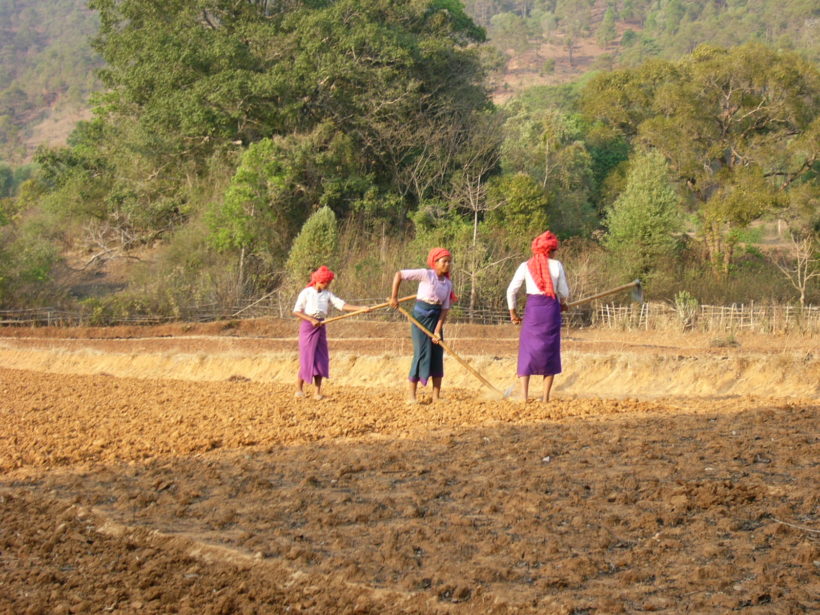 By Ruchi Soni
By Ruchi Soni
Ma Khine, a mother of four, talks about how the installed solar mini grids in the Myin Chi Naing village in Myanmar electrify the streetlights that make her feel safer. Her friends excitedly share how the electric-powered pesticide sprays save them time and effort in their farms. Another villager in the Ton Lon village proudly displays how the diesel mini grid powers a submersible water pump from a 200-foot well. The villagers are also grateful for the mini grid to provide light after daylight hours to allow them to sort crops, something they wouldn’t be able to do previously after it got dark. The new batteries store enough energy to allow the villagers to store their rice and turmeric harvest.
These are just few of the experiences people shared during a visit to the village as part of an event on Upscaling mini grids for least-cost and timely access to electricity services, held in Nay Pyi Taw, Myanmar in February 2017. The World Bank’s Energy Sector Management Assistance Program (ESMAP) and the Climate Investment Funds (CIF) jointly organized the event.
Event participants visited two villages in central Myanmar – Myin Chi Naing and Ton Lon – that are away from the country’s main grid and are currently served by mini grids, one powered by diesel and one by solar PV. Both mini grids are owned and operated by the local Village Electricity Committee (VEC). Residents of those villages were eager to share how electricity generated by the mini grid has provided many opportunities for men and women in central Myanmar, which are not connected to the main grid.
In Myanmar, approximately 70 percent of the population and 84 percent of the rural households do not have access to electricity. The Myanmar National Electrification Plan (NEP), funded by the World Bank and other partners, aims to achieve 100 percent electrification by 2030. However, the challenge to reach this goal is huge. Electricity shortages and supply disruptions are widespread in Myanmar due to under-investment in the sector.
Mini grids using locally engineered and financed technology have played a crucial role in the provision of electricity for thousands of villages in the country. These mini-grids largely emerged due to the entrepreneurial drive from the local private sector and community organizations with little or no public sector support. They also simultaneously reflect the determination and ingenuity of many local communities in finding alternatives to candles and kerosene.
In the village of Myin Chi Naing (Kyaukse Township, Mandalay District), three identical 3.6 kW solar PV mini grids provide electricity to 200 households. Yangon-based company (SolaRiseSys) built the mini grids, as part of an Asian Development Bank (ADB) mini grids’ pilot program. Collectively the three systems in Myin Chi Naing village provide electricity to 200 households, a monastery, and a library.
It operates through a pre-pay metering system where households purchase electricity using magnetic cards. All customers are signed up for the basic package, which provides up to 100 watt-hours per day and a maximum of 50 watts at any time. Tariffs are 1500 kyat (approximately US $1) per month. The system powers two five-watt LED lights, a USB charging port, and a 230-volt electrical outlet, in each household. In addition, many households use the electricity to charge cell phones and watch TV. Currently, the households consume up to 3 kilowatt-hours per month, and pay about US $1.2, based on their consumption. An interesting feature of this system is its “grid-readiness’’–that is, electricity is distributed on grid-ready concrete poles. In addition, the inverter has the ability to connect with the grid, using grid power to charge batteries and providing the mini grid with a supplemental source to the solar. This is to say that the present inverter could be swapped out for an inverter with the capability for bidirectional power flows, injecting solar electricity into the grid when batteries are charged and the solar panels are providing a surplus.
The second mini grid is a 10 kW diesel unit in Ton Lon village, which is an example of typical village-operated mini grids found in much of rural Myanmar. Ton Lon village has 97 households, of which about 30 are served by a diesel generator-powered mini grid. The VEC comprising of 14 individuals own and manage the generator, and split into groups of two to start and stop the generator every day. Each household pays an approximate fee of US $1.84 (2,500 kyat) per month for a 26-watt CFL or US $3 (4,000 kyat) per month (for powering a CFL and a television). Payment of the monthly fee entitles the household to use of pumped well water available from a water tank immediately adjacent to the generator. The remaining 60+ households cannot afford the monthly fee and thus, are not served by the mini grid. The generator was provided to the village in FY 2015-6 and this installation is one of many similar installations by the Department of Rural Development (DRD) in the area. This case represents thousands of other diesel mini-grids established by local communities. In addition, to diesel mini-grids, Myanmar has a strong prevalence of locally designed and implemented biomass gasifiers and micro/mini hydro projects.
There is a Burmese phrase used by local practitioners – “ko-htu-ko-hta min-lin-yae” – which literally means “self-reliance electrification.” Visiting these two sites show the incredible ingenuity by the local communities in developing these systems, while also highlighting the significant opportunities that exist to both to upgrade existing mini grids and to develop new sites. The takeaway is that there are untapped opportunities that exist for providing better access to reliable and affordable electricity that can in turn enable pro-poor growth.
Editor’s note: This post originally appeared on the United Nations Foundation’s website: http://energyaccess.org/news/recent-news/mini-grids-providing-electricity-to-myanmars-communities-away-from-the-grid/
Ruchi Soni is Manager of Energy Access at the UN Foundation, where she oversees the Energy Access Practitioner Network and the Foundation’s involvement in the Mini-Grids Partnership. She worked for the World Bank for nine years, where she was responsible for the design and scaling-up of commercially-viable and innovative business models for electricity access. More recently, she was the program manager at wPOWER, a U.S Department of State initiative, where she directed program development and donor management. Soni also led the messaging and communication for wPOWER Hub’s impact.



Leave a Reply